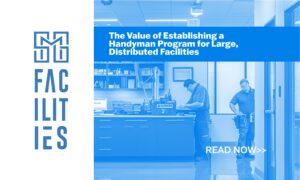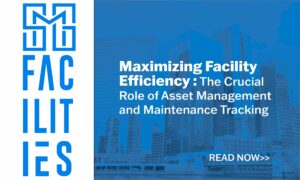There’s no doubt about it. No matter your industry, data is critical to your business. Many people claim that data is the most important asset you can possess, more crucial than your organization’s capital assets. Your data reflects your entire business: intellectual property, broad market trends, invoicing and expenditures, needs and pain points of prospective customers, your organization’s customer base, and much more. All that information is embedded within the data your company collects, analyzes, and stores. Reliable data is needed to make vital decisions every day. You could make the statement that data is the lifeblood of your organization, providing everything necessary for your business to thrive and prosper.
For years, businesses have used data to analyze and optimize nearly every aspect of operations. However, despite the broad adoption of data in other segments of their operations, companies have been mainly reluctant to harness the power of data to improve facilities management. Yet, according to Forbes, 59% of businesses use data analytics to make better decisions and increase their business performance.
Harnessing your organization’s maintenance analytics data can help you address your facilities management team’s challenges. SMG is an integrated facilities management company that was purpose-built to drive profit improvement through better facilities management – we help shippers reduce costs, gain visibility, and plan for the future. We take a “client first” approach that enables you to streamline your operations, reduce maintenance costs, extend the life of critical equipment, and ensure minimal disruption to your facilities.
We take the burden off your facility team’s plate when tracking maintenance spend, vendor management, and more. We provide people and processes that consistently drive profit improvement through better facilities management.
What is Maintenance Analytics?
Maintenance analytics utilize the facility data you collect to guide the actions of the facilities and maintenance team and measure the impact of those actions. In addition, maintenance analytics are used to identify key data trends, patterns, and insights within facility data. Your teams can then apply the information gleaned to improve visibility, make better decisions, and plan strategic initiatives to improve overall performance.
Four types of data analytics are available to facility managers (FMs):
- Descriptive analytics highlight or describe a specific trend in your facility.
- Diagnostic analytics can help you determine what is causing or driving revealed trends.
- Predictive analytics forecast new trends and help you predict future occurrences.
- Prescriptive analytics give you data-driven insight into how you can influence new trends for better, more desirable results.
By using each of the above analytics types, you can progress toward achieving better facility management outcomes for your organization.
Benefits of Maintenance Analytics
Maintenance analytics can help facilities professionals in some significant ways:
- Enhanced Visibility – Gain a bird’s eye view into equipment, spend, service provider performance, facility sustainability, and repair and maintenance (R&M) volumes.
- Increased Efficiency – Prioritize resources where they will make the most significant impact, avoid common bottlenecks, and improve efficiency by referencing analytical data.
- Reduced Costs – Allocate capital intelligently and strategically via the supplier, contractor, trade, category, district, and region-specific data.
- Data-Backed Decision-Making – Base all resource allocation, asset management, and contractor sourcing decisions on concrete analytical insights.
- Predict Spend – Calculate anticipated future maintenance spend and outcomes intelligently through FM analytics. Prioritize repair and maintenance activities based on predicted business value.
- Improved Work Quality – Evaluate individual service provider performance to ensure all work meets your high standards.
Challenges of Data Analytics for Facilities Management
Only some things are as easy as they seem. In the spirit of transparency, here are a few challenges to consider when dipping into data analytics in facilities management.
Cost of Implementation
While data analytics can be valuable, it can be costly. Quantifying the cost of a data solution can take time. Success hinges on the impact of the changes you make after assessing the data and implementing improvements. Cost comprises the expenditures on the software, the number of data sources, and the hours of analysis and support. Companies should set aside between 2% and 6% of their total budget for data analytics.
Gathering and Understanding Data
Companies can face a significant challenge when sorting through all the various data sets to derive valuable insights that produce actionable, data-backed decisions.
Using the right tool, correctly training the employees who will be sifting through your data, and cultivating an environment that encourages learning, you can make data analytics a powerful instrument for your company’s success.
Data Security
These days, data breaches happen all the time. We hear about them all the time. A company that adds data analytics should step up the measures to protect that data and minimize the risks of potential attacks as much as possible. Mitigating those risks requires taking some precautions, including:
- Controlling access rights
- Encrypting data with secured login credentials
- Conducting training on handling big data.
Hiring a professional cybersecurity company is another option to assist in monitoring your systems.
But challenges can be faced – and bested – by choosing the right facilities management solution. Using maintenance analytics data to optimize facilities management processes, facilities managers can improve operations, bolster resiliency, and gain insight into the future.
Problem, Solution: How “Actionable” Data Helps Address the Key Problems of Facilities Management
Facilities professionals face daily challenges. Things like compliance, the hybrid working environment, sustainability, and striving to keep up with technology (such as the devices connected to the Internet of Things (IoT)) come to mind. Therefore, facilities professionals must work to understand the most effective ways to turn the challenges they face into opportunities for improvement.
Let’s look at some specific challenges facilities management teams face and how SMG Facilities can help solve them.
Problem: Chaotic Costs Are Difficult to Track
Facilities professionals generally live in what you might call a “reactive” state: they chase (and put out) fires all day. They are, in a manner of speaking, firefighters. Their world consists of constant disruption, and priorities shift instantly — in real-time, making costs challenging to track.
Solution: Streamlined Spending Tracking Turns Chaotic Costs into Concrete Analytics
SMG Facilities can provide a lifeline to your facility team or the parent company by leveraging “actionable” data so that you can avoid those fires. We offer a proactive response that becomes the norm, and, as a result, total cost reduction occurs.
Effectively managing distributed assets can be a headache. We take the burden off the facility team’s plate in tracking maintenance spend, vendor management, and more by providing our clients with people and processes that consistently drive profit improvement through better facilities management.
Specifically, we help you align portfolio-level maintenance and project-level budgets while tracking expenditures in real time:
- Develop a holistic facilities project for a location, apply a template, and create one-to-many maintenance budgets, including detailed line items covering expense and capital items.
- Track incoming invoices and work orders to capture spend versus budget at line-item, facility, and program levels.
- Provide visibility into spend in real-time and stay on top of the money spent on repairs versus replacement.
Problem: Without Reliable Service Providers, Facilities Professionals Scramble for Help
Another challenge for facility professionals is consistently finding reliable and vetted service providers. Where do you turn when you find out your regular service provider for a specific job is unavailable, has encountered insurmountable challenges, or has gone out of business?
Solution: Intelligent Trade Selection Brings Logic to Service Provider Selection
Wouldn’t it be great to review asset histories, landlord/tenant responsibilities, and store strategies to optimize decision-making while simultaneously enforcing SLAs and NTEs – all in one place? It’s all about intelligent trade selection. SMG offers the ability to leverage a client’s existing technology and maintenance history to help you identify the issue, problem code, work acceptance code, NTE (not to exceed) thresholds, impacted area(s), SLA, and whether it is an expense or a capital expenditure. Route requests are based on associated trade and a Predetermined statement of work. And you can categorize work by type and inform the associated personnel.
The Future of Maintenance Analytics is Streamlined
As operations grow, it becomes increasingly more work for facilities professionals to maintain a holistic understanding of maintenance schedules while constantly managing maintenance crises. Integrated facilities management software from SMG uses analytics to provide an at-a-glance overview of complicated maintenance operations.
SMG simplifies (streamlines) the process. By leveraging our technology and expertise, we make your job easier and your actions more effective. For example, our proven processes associated with facilities management drives efficiency by improving the facility management workflow, creating end-to-end transparency of the work being performed, and tracking work order management from input through resolution.
The activities that take place daily across your portfolio become critical data points that our advanced analytics transforms into relevant and actionable business intelligence, yielding information you can use to make essential decisions that positively impact your business.
Partner with SMG
Don’t be reluctant to harness the power of data to improve your facilities management. By collecting raw data and aggregating it into actionable analytics, SMG’s integrated facilities management service helps reduce costs, gain visibility, and plan for the future.
Facilities professionals must work to understand the most effective ways to turn the challenges they face into opportunities for improvement. Enhanced visibility, increased efficiency, reduced spend, data-backed decision-making, predicted revenue, and improved work quality are all reasons for reaching out to SMG to help your facilities management team reach its maximum potential. Reach out and partner with SMG Facilities today.





